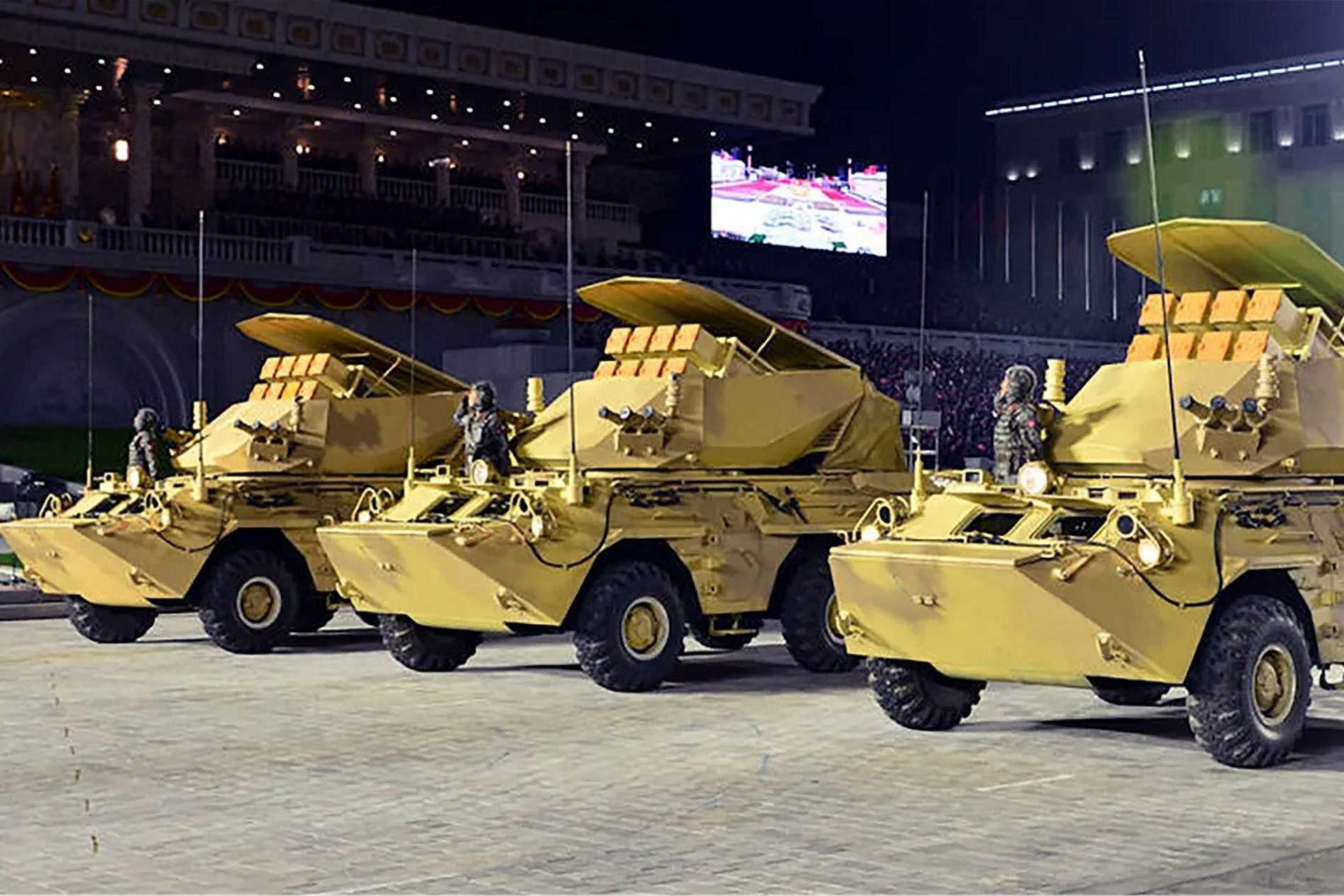Breaking News
Breaking News: Ukraine Destroys Bulsae-4 Anti-Tank Vehicle Confirming North Korean Combat Vehicle Deployment.
According to information published by the Euromaidan website on November 30, 2024, Ukraine's Third Assault Brigade confirmed the destruction of yet another North Korean Bulsae-4 anti-tank missile vehicle in Kharkiv Oblast, further substantiating reports of North Korean military involvement in the ongoing conflict between Russia and Ukraine. The strike, executed by the brigade’s Windbreaker drone unit, was documented and shared publicly through video footage, demonstrating the precision of Ukraine's drone operations.
Follow Army Recognition on Google News at this link

North Korean Bulsae-4 anti-tank missile vehicle displayed at a military parade. Another Bulsae-4 was recently destroyed by Ukrainian forces in Kharkiv Oblast, confirming the deployment of North Korean combat vehicles in the war. (Picture source: North Korea News Agency)
This event marks the second confirmed instance of North Korean combat vehicles being deployed in Ukraine, following the first sighting of the Bulsae-4 missile system earlier in 2024. The destruction of this advanced weapon highlights the increasing role North Korea is playing in supporting Russian forces, contributing to the ongoing military campaign in Ukraine.
The Bulsae-4, a long-range, non-line-of-sight anti-tank guided missile system, is one of the most advanced weapons in North Korea’s arsenal. Its mobility and precision allow it to strike armored targets at significant distances, making it a significant threat to Ukraine's military vehicles. The system’s presence in Ukraine adds a potent layer of firepower to Russia's military capabilities, particularly in eastern Ukraine, where intense combat has raged since the beginning of the war. Ukrainian forces have increasingly relied on drones for intelligence gathering and precision strikes, and the destruction of the Bulsae-4 is a testament to their ability to counter sophisticated weapons despite their growing technological challenges.
The growing role of North Korean military assets in Ukraine is not limited to missile systems. North Korean soldiers have been deployed to the conflict zone as well, marking a significant escalation in foreign military involvement. According to Ukrainian officials, North Korean personnel began arriving in Ukraine as early as the summer of 2024, providing technical support and training to Russian forces on how to operate advanced North Korean weaponry. While the exact number of North Korean soldiers in Ukraine remains unclear, reports suggest that several hundred have been embedded with Russian units, primarily in the Kursk region of Russia, near the Ukrainian border. These soldiers have reportedly been involved in a range of activities, from offering tactical advice to directly participating in combat operations alongside Russian troops.
The first confirmed clash between North Korean soldiers and Ukrainian troops occurred on November 6, 2024. Ukrainian Defence Minister Rustem Umerov revealed in an interview with South Korean broadcaster KBS that Ukrainian forces had attacked a "small group" of North Korean soldiers. This marked a significant turning point in the conflict, as it was the first instance of direct combat between North Korean and Ukrainian troops. US officials also confirmed that North Korean soldiers had been engaged in combat operations in the Kursk region on November 4, 2024. According to reports, an estimated 11,000 North Korean soldiers were stationed in the Kursk border area, where they have been involved in supporting Russian operations. South Korean and US intelligence, as well as NATO, have all reported evidence of North Korean military personnel participating in the war, with the recent clashes in November further corroborating these claims.
The deployment of North Korean troops to Ukraine follows a series of high-level meetings between Russian and North Korean officials, including Russian Defense Minister Andrei Belousov's visit to North Korea on November 29, 2024. Belousov’s visit, which was officially acknowledged by the Russian Ministry of Defense, focused on strengthening military ties between the two countries. While the specifics of the discussions have not been fully disclosed, it is widely believed that the talks centered on the continued supply of military aid, including advanced weaponry like the Bulsae-4 anti-tank armored vehicle, as well as the potential for more North Korean soldiers to be deployed to the front lines in Ukraine.
For Ukraine, the growing presence of North Korean soldiers and military hardware represents a significant escalation in the war. The involvement of foreign troops and advanced weapons systems adds new complexity to the already tense battlefield dynamics, requiring Ukrainian forces to adapt to unfamiliar tactics and countermeasures. The presence of North Korean soldiers in Ukraine is not only a direct challenge to Ukraine’s military efforts but also a clear indication of the deepening military cooperation between Russia and North Korea, which continues to shape the broader geopolitical landscape of the conflict.
The increasing role of North Korean support in the conflict is a growing concern for Ukraine and its allies. As the war evolves, foreign military involvement appears to be intensifying, with both Russia and North Korea seeking to gain an upper hand. For Ukraine, countering the combined threat of advanced weaponry and foreign military personnel will require sustained international support, particularly from NATO and its partners. The international community will continue to monitor this development closely, as the involvement of North Korea in Ukraine further complicates an already complex and devastating conflict.
In conclusion, the destruction of the North Korean Bulsae-4 anti-tank armored vehicle, alongside the confirmed deployment of North Korean soldiers to Ukraine, marks a significant escalation in the conflict. The growing alliance between Russia and North Korea is reshaping the dynamics of the war, adding new challenges for Ukrainian forces as they battle both conventional and unconventional threats. The global implications of this deepening military cooperation between the two nations are profound, as the war in Ukraine continues to draw in more external actors, each with their own strategic interests.


























